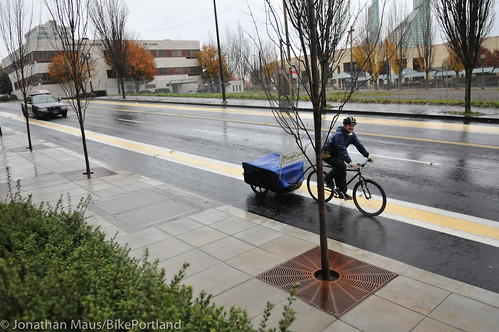
(Photos © J. Maus/BikePortland)
The Bureau of Transportation has been busy since our last update on the NE Multnomah Street Pilot Project. In addition to sharing the latest changes on the street, I also want to address a few issues readers have brought to my attention.
The first thing I noticed this morning were the new plastic bollards — a.k.a. “traffic delineator wands” — PBOT has placed in the yellow buffer zone. These bollards help remind folks to not park in the bike lane (which is now curbside) or in the buffered area. The bollards also help give bicycle operators the perception that they are protected from auto traffic. I like that PBOT continues to experiment with plastic bollards because, as we’ve detailed in the past, they have had problems keeping them anchored to the ground in the past. I think we could do wonders to our bikeways all over town if we used these bollards more frequently.
Another addition since my last report is green zebra striping in the bike lane at a few of the intersections. These are done to mark caution areas for people turning right over the bike lane and they are done to remind folks using the bike lane that it continues onto the next block.
Speaking of green in the bike lane on Multnomah. I’m curious why PBOT isn’t using more of it. Given the new green paint applied on SW Stark and Oak, it seems we could send a consistent signal to road users that high traffic (or high value, network-wise) bike lanes are green. I’m also awaiting an answer from PBOT as to why/how the yellow color was chosen for the buffer area. Several of you have asked me, “What’s the yellow for?”. (I’ll update this story when I hear back.)
Another issue that has come up are the shared zones at bus stops.
TriMet issued a press release about the project last month that stated:
“While buses serve stops, drivers and bike riders are expected to stop behind buses… TriMet asks motorists and bicyclists to watch for and comply with the flashing “Yield” light on the back of the bus as it pulls out.”
This makes it sound illegal to pass a bus when it’s servicing a stop. Last time I checked, it was legal to pass a stopped bus as long as the “Yield” light was not flashing.
UPDATE: TriMet Public Information Officer Roberta Altstadt just clarified that their statement was meant “as a recommendation, an important one for the safety of people on bikes.” “Generally, bike riders can safely pass on the left of a bus servicing a stop. However, in this specific location, where there is very limited space, it’s recommended that for safety reasons, bicyclists stop and wait for the bus to pull back into the travel lane before continuing safely into what becomes the buffered bike lane.”
Another word about sharrows and mixing zones on Multnomah: When the protected bike lane ends at intersections where motor vehicles turn right, remember to assert your position in the middle of the lane. Don’t be shy. If you ride to the right, near the gutter, you only increase your risk of right hooks.
Now, onto an area of the project — from MLK Jr Blvd west toward the Rose Quarter Transit Center — that wasn’t finished at all last time I was out there. PBOT has re-configured the roadway to make room for a wide bike lane and buffer.
The buffer narrows considerably as the lane heads down toward the Rose Garden (and I noticed PBOT added small reflectors in the buffered area)…
As you come to the I-5 overpass at NE 1st Ave., you can either leave the bike lane and turn left to go south through the Rose Quarter Transit Center, or do a two-stage left turn by using the bike box at NE Wheeler Ave.
Also at the intersection of NE 1st Ave. is a new housing development dubbed The Milano. Yes, it’s named after the famous Bianchi Milano city bike. With 90 on-site bike parking spaces (just 12 for cars) and a bike repair station, The Milano is a great example of bike-oriented development. Now with protected bike lanes in all directions right outside its doors, it might be the most bike-friendly residential development in Portland.
And there are still more changes to come. PBOT will be installing large potted plants inside the buffer zone and they’ve got a few on-street bike parking corrals to put in. Like I’ve been saying, this redesign of Multnomah is sort of a big deal for PBOT. And it’s also considered a pilot project, so your feedback (both here and to PBOT directly) is very important.
Learn more about this project via PBOT and past BikePortland coverage.



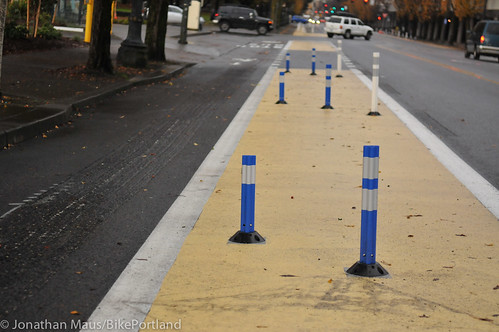
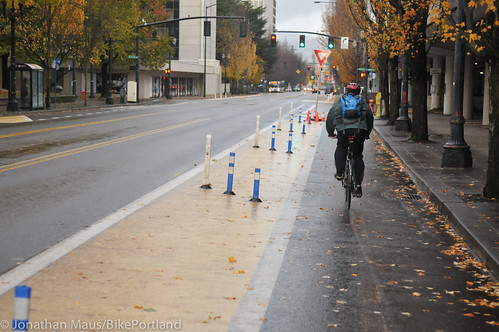

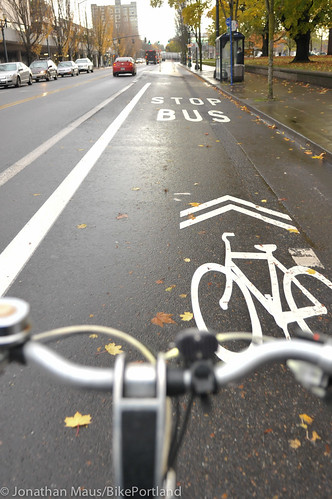
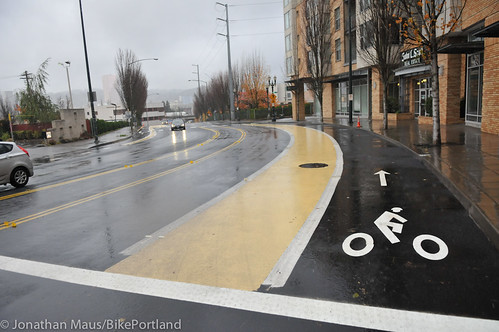

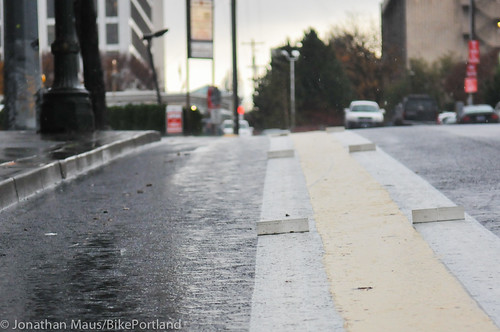
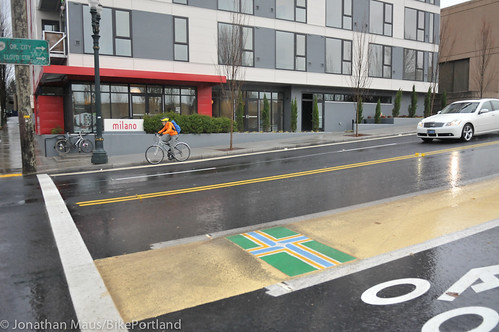
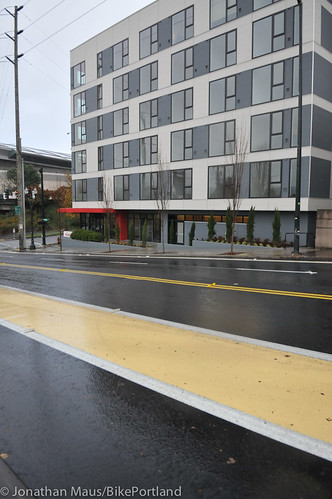


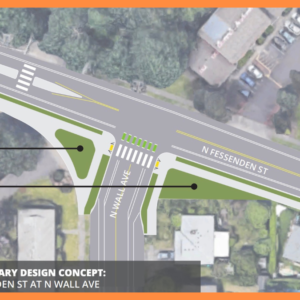


Thanks for reading.
BikePortland has served this community with independent community journalism since 2005. We rely on subscriptions from readers like you to survive. Your financial support is vital in keeping this valuable resource alive and well.
Please subscribe today to strengthen and expand our work.
>>Another addition since my last report is green zebra striping in the bike lane at a few of the intersections. These are done to mark caution areas for people turning right over the bike lane and they are done to remind folks using the bike lane that it continues onto the next block.
Thanks for clearing that up. I never would have guessed what that meant. I wonder how many vehicle drivers also don’t know what it means, and who is going to tell them? It seems more intuitive to have the whole bike lane green and extend that through the intersection completely.
Also, I wondered why the bike lane suddenly turned into a right turn lane and wondered if I was suppose to move into that narrow strip separating the right turn lane and the straight lane to the left of it. So the right turn arrow doesn’t apply to bikes? That’s confusing.
The sign with the right turn arrow says “Except bus and bike”.
if they kept the paint through the intersection the motor vehicles would just wear it down into the same zebra stripe pattern…
I remember when there were no bike lanes between Grand and MLK, and lots of buses. But it can’t be said enough that while this stretch of road needed a diet, the bike facilities really are there for motorists. For two reasons: 1. they define space for motorized and non-motorized vehicles, making driving easier and less subject to delay, and 2. they make it more likely that more trips to and thru Lloyd District are done by bike, reducing demand for the motorized vehicle lane space. Image the Hawthorne Bridge if half those now biking switched by to driving a car.
Those plastic bollards look terrible. Seriously bad.
Also, the green bike boxes have created a “vocabulary” for bike facilities that implies that the painted areas are the places where bikes are supposed to go.
These painted buffers confuse that vocabulary. I have seen several people biking in the painted area, navigating between the bollards, instead of riding in the actual bike lane over to the right.
Agreed, on both counts.
It seem to me it would have been more intuitive to paint the buffered area with diagonal white strips and have the bike lane in green all the way.
eh. I don’t really agree. The vocabulary is that green is a lane for bikes. The buffers are not a travel lane. If the buffer was green it would be incredibly confusing and tons of bikes would be riding on it. If the buffer wasn’t painted at all it would just look like a “no mans land”.
I don’t find the yellow confusing at all.
It looks “greenish” to me. It probably does to a lot of us color challenged folk, actually.
to me they imply that the painted areas are not for motor vehicles to drive on…
when I’m driving and the pavement changes color like that I look around to make sure I’m where I’m supposed to be and haven’t inadvertently driven onto some kind of pedestrian plaza…
but when I’m on a bike and I see paint, of any color, I feel welcome and my mood is lighter…
So how are they going to keep the bike lanes clean in the zones with the bollards? It looks narrower than a standard city street sweeper…
The wall of parking on the eastern end reduces visibility and will likely lead to accidents at intersections. A cyclist going 15 mph (a typical speed in portland) will only become fully visible to motorists for a few seconds before entering the intersection. Why does PBOT continue to build facilities that prioritize parking over cyclist safety?
Why on earth would PBOT paint a ~6 foot wide lane beige and then make it completely unusable by placing large circular planters in the middle. Its not about protection or buffering since bollards and/or concrete barriers could be placed on the outside edge of the buffer. The buffer should not be wasted space – it should be available for cyclists who need to avoid hazards or to pass other cyclists.
Because businesses keep refusing to get on board with building safer facilities instead of prioritizing excess parking, and PBOT hasn’t got up the mettle to push past that.
just because they didn’t put something there doesn’t mean that the space is a waste… it’s for evasive bike maneuvers and people unloading cargo… it’s also less space for polluting vehicles…
yeah your are correct about the road diet component of this project.
i also really like the idea of using the bollard and planter-obstructed buffer to practice evasive maneuvers, bunny hops, slides, and jumps.
I started using NE Multnomah this week instead of going all the way over to N. Vancouver and so far I like it and it seems to work pretty well. I would like to 2nd taking the lane in the mixing zones. Saw a bike hugging the side of the road to the right of a right turning truck at MLK this morning. Definitely watch out for that kind of thing. Hats off to both the guy driving the truck and the guy on the bike for making eye contact with each other and being cautious. It will be super nice once the planters have been installed.
The yellow buffers are so illogicial. Yellow lines are supposed to divide lanes moving in opposite directions. It’s not the same yellow, but regardless, so random.
Do the vehicles parking in the buffer (as shown above) receive traffic tickets? It’s about the same as if they parked one foot into the travel lane. It totally negates the intended door zone buffer.
Now would be a great time to email Mayor Adams, PBOT (and CC Charlie Hales!) to say that you appreciate spending the political capital to build a tremendously awesome bike facility through the heart of the Lloyd District.
My hunch on the paint job: painting the buffer is cheaper in the long run than painting (and re-painting) the bike lane.
Also, I’ve heard some folks grumble about thermoplastic and paint being slippery in the rain?
Never found that to be true, but plenty of people were saying it. You have to wonder if it got to the people who design it.
i love this so much! it’s a direct, visible way through the lloyd district that puts us in the middle of a business district rather than off to the side like ankeny, going or tillamook. it connects to another large bikeway link (esplanade). more of this, please!
not everyone has gotten the message about not parking in the bike lane, though. i called parking enforcement for one car and spoke to the occupant of another car who had pulled off to look for directions. green paint would have solved that, i think.
I am really excited about this, but it still has some issues — in particular, the narrow designated parking zones, and the fact that at several of the bus stops there is no ‘merge back out’ area — my bus driver today was having a lot of trouble. I wrote to the project manager (Ross Swanson) to express both my excitement and my concerns.
The signal re-timing is not finished either, but the ever-wonderful pkoonce assured me they are working on it.
I got to use the newly improved bike lane last Friday after a dentist appointment. I will say that the yellow was confusing at first because it’s a new treatment- I turned left onto it instead of the bike lane at first, thinking the yellow was the bike lane itself (like on Stark & Oak). Overall I thought it was a wonderful improvement.
My nitpicks: the part where the old stripe was removed was very rough and limits the amount of space you have to use in the bike lane, especially when there’s downed leaves and storm puddles, and especially farther east towards the Lloyd Cinemas.
Also, I’m not sure where exactly, but the bike lane kinda…disappeared somewhere around 17th or 19th. I was going straight through and at 21st I was suddenly squeezed between or into one of the vehicle turn lanes.
To be fair, the part where it disappears where 20th would be has already been that way (http://goo.gl/maps/67GBu), but with the improvements for eastbound traffic between the Rose Quarter and 15th, you would think the bikeway would continually a little more formally.
How should we give feedback to PBOT? On the page you linked to I see things that are about reporting problems but I’m not sure which one should be used to give them general feedback about something like this.
the picture shows that even the police aren’t respecting the new lanes… and they’re supposed to set a good example…
safe@portlandoregon.gov, or 503-823-SAFE, I’m guessing.
From the corporate Lloyd district logo featured at the ends of the buffer zones, I just assumed that the choice of butter-yellow was based on branding–to blend with or offset that logo.
All in all, I’m enjoying the new lanes–Multnomah is my daily commute and it mostly feels much freer and safer now. But it’s way trickier than it used to be to get out of the eastbound bike lane to make my left turn onto 9th. The road diet means fewer gaps in traffic to get across the lanes there, and the bus-bike-car-merge-intersection-diagonal-stripes-dots-bollards thing going on right there is SUPER confusing and therefore more dangerous. At least till everyone gets used to it.
It’ll be great to get the planters in. Interesting photo showing parked cars where people parking those cars thought it best to park partly in the yellow buffer area. It’s consistent so I wonder if the adjacent lane is narrow. This behavior will continue unless a change is made.
Intentionally commingling buses and bikes is really folly. Put bluntly, I really hate interacting with buses. Williams is an excellent example of bikes and buses moving at the same average speed but involves leapfrogging and stress for all parties. On other occasions buses are picking up/dropping passengers and I’m forced to do a quick assessment of how quickly people are getting on and guess how many might be departing. All this calculus is done to ensure that I pass if/when it is safe. Sometimes I err conservatively only to find the bus waits for a few minutes which causes all sorts of confusion and angst to drivers behind me. Other times I pass at the exact moment the bus’s motor is at full roar as it merges left leaving me in a dire predicament.
There has to be an elegant solution to move people by bus without creating a need for hyper vigilance and fuzzy-math statistical risk assessment while riding.
Since they have the money for this, they must also have the money to finally fix the catch basins on Capitol in Hillsdale. When they repaved a few years ago they never brought the catch basins up to the level of the new pavement. (Yes, I’m also sending this comment to safe@portlandoregon.gov .)
Sent, but minus the snark.
in one of the photos there is a Yield sign in the yellow buffered area before an intersection…. which lane is supposed to yield the right of way?
I agree with spare_wheel and others questioning whether parking is wise or necessary in areas with divided bike lanes. Particularly when the Lloyd Mall parking is adjacent. These island parking spots are dangerous for everyone involved – and pretty much impossible to use if you have small children in tow. Why not just dispense with the parking, and maybe even get to keep that extra lane for cars?
Traffic on Multnomah ground to a halt last Friday because of the diminished access – there must have been an event at the Rose Garden… Seems like the best course is to pick two – flow and bikes, flow and parking…without widening the boulevard itself, how can we expect to win on all three?
Lloyd District businesses insisted on the parking I believe; it’s one of the reasons why the project was done instead of closing Holliday.
Meanwhile over on Holladay….virtually no cars.
Those little reflectors are nearly useless. They installed them on the eastbound Hawthorne bridge, and they don’t stay stuck to the round – scattered hither and yon as cars wipe them off the pavement.
So when are they going to utilize some of that buffer space to put in green “Portland Pivot” boxes at the far sides of intersections? What is the current expectation regarding cyclists making left turns?
A) “We don’t expect cyclists will want to make left turns”
B) “Cyclists should merge across the buffer between bollards, parked cars and planters and pop out in front of drivers in the non-buffered lane, then merge across that lane into the left turn lane”
C) “Cyclists are expected to merge to the right, across the crosswalk and position themselves 1) in the crosswalk, blocking it, or 2) to the right of car traffic, then wait for the cross-street light”
D) “We expect cyclists wanting to make a left turn to overshoot their destination street by one block, then circle the block via right turns and proceed straight across Multnomah on their destination street”.
E) “What kind of turns?”
F) “If cyclists, for whatever unknown reason, want to turn left at any point, they should stop on the near side of their destination street, dismount, wait for the walk signal, proceed across their destination street to the opposite sidewalk, wait for the walk signal there, then walk their bikes across the crosswalk, then re-mount and merge back into the bike lane on their destination street”
I might be exaggerating a little bit, but this is one of my pet peeves with gilded-cage, gauntlet-style infrastructure that “give[s] bicycle operators the perception that they are protected from auto traffic”: no good left turn options. My other ones have already been mentioned: hidden cyclists suddenly appearing “out of nowhere” at intersections, inability to utilize available road space for passing or hazard avoidance, difficulty keeping the area free of hazards such as broken glass, wet leaves, or snow, etc.
I remain very skeptical of “protected” facilities such as this one, but maybe they will serve a useful purpose somehow. I’m afraid I will be very difficult to convince, though.
of course there is option (g), simply assert the travel lane at least one block, maybe two or three, in advance of your intended left turn, and be prepared not only to fight the possible ticket but more immediately to endure the abuse of the motorists with whom you are sharing the road.
cyclists asserting the travel lane causes motorists to become anxious and fearful. thank goodness pbot is working hard to ease this fear and anxiety by installing planters and bollards in a “buffer” zone.
I’ve had success using the “Portland Pivot” even without the green boxes. Drivers on the cross-streets are stopped anyway and don’t seem to care if I pull up next to / in front of them.
Green boxes would of course be better…
a pivot requires you to interact with distracted motorists in an intersection for a longer period of time. is this really the kind of maneuver that a 7 year old can do with confidence? also, when i pull in front of motorists at intersections some appear to care very much indeed.
Why is it so difficult to build bus stop islands in places like this and on the Hawthorne Bridge viaduct, it would greatly benefit bus riders and bike riders? It would allow bikes to ride carefully between the sidewalk and bus stop island and avoiding the conflict btwn buses and bikes.
Agree that the partial green zebra striping is confusing. I ride across the one at 6th Ave when I cross Multnomah on my commute. Until reading this, I thought it was just not completed (although given that it’s been two weeks that’s seemed less and less likely).
So I don’t think anyone’s going to know what it means. Especially since the bike lane itself isn;t green.
I road this today and found nothing about it confusing or stressful. It is a massive improvement. Thank you PBOT!
Great piece on Portland’s transportation strategy over on Portland Transport by Chris Smith and Randy Miller. It was published in The Oregonian. Spending on bike facilities makes things better for folks behind the wheel as well.
This expectation of TriMet’s that rude people riding bikes are any more likely to stop patiently behind a business than car drivers speaks to the bigger issue of perception of cyclists on the road.
Not that TriMet thinks they can rewrite the law but that they can simply muscle in on bicycles because a bus is large, imposing and potentially lethal to legal road users not in a metal cage.
It is endemic of a societal thought process whereby abuse of the weak is acceptable because it is easy to do, fun and/or hard to prosecute.
it does say “drivers and”
From the PBOT web site:
Contact
For more information, contact project manager Ross Swanson at multnomah.mainstreet@portlandoregon.gov or 503-823-6829.
I cycle these improvements several times a week and, yes, they are a big improvement. But PBOT is seriously over-thinking the use of paint (just like they’ve been overthinking the installation of signs for years). This is going to cost a lot of money to maintain in 5 years.
As was observed by others in this thread those green dashed boxes in the middle of intersections do not make any intuitive sense to riders or drivers. And what are those toothy triangles where a car lane merges with a sharrow supposed to signify?
This is a job for the KISS principle.